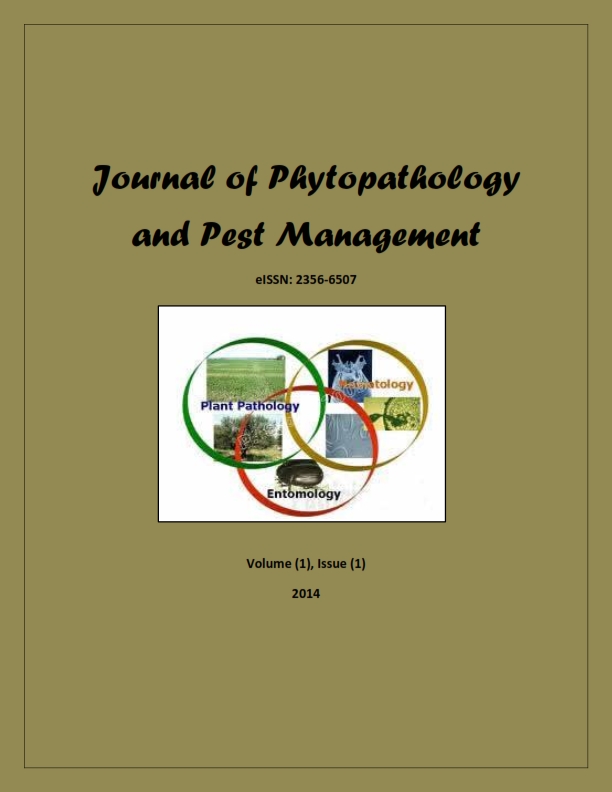Impact of the resistance to Pirimicarb on the ability of the cotton aphids, Aphis gossypii Glover (Homoptera: Aphididae) in transmitting plant viruses
Keywords:
cotton aphid, resistance, Pirimicarb, plant virusesAbstract
The present investigations were undertaken to identify the relationship between pirimicarb resistance in Aphis gossypii Glover and its transmitting cucumber mosaic virus (CMV) potency to squash plants.
Data show that the percent of plants infested by mosaic virus transmitted by the dark form of cotton aphid, commonly, was higher than that inoculated by the light form. In the base line of Assiut aphid colony, virus infestation% caused by light and dark forms were 46.3 and 55.5 respectively, whereas, the infestation percentages of light and dark colored forms after one year of pirimicarb selection were 65.1 and 94.3 respectively. Data of light and dark colored forms of New Valley aphid colony, gave the same trend of Assiut aphids. The percent of plants infested by mosaic virus transmitted by the dark form of cotton aphid was higher than that inoculated by the light form. In the base line of Assiut aphid colony, virus inoculation periods in case of light and dark forms were 23.0 and 11.0 days respectively and after one year of Pirimicarb selection were 15.0 and 7.5 days respectively. The inoculation period of mosaic virus transmitted by the dark form of cotton aphid, commonly, was shorter than that of the light form. In the present study, it is clear that the ability of cotton aphid expressed as % infection of inoculated plants is resistant correlation as 64% of the differences in plant virus infestation are due to the level of pirimicarb resistant value. This finding may be attributed to the inoculation period which has a negative correlation with the pirimicarb resistance level. This negative correlation means that the more of resistance level, the less of inoculated period. The coefficient of determination was found to be 0.7 which indicates that 70% of the variability in inoculation period is due to pirimicarb resistance level. Our studies lead to the fact that the presence of the dark form of cotton aphid in the normal conditions is an alarm telling us that the aphid colony is going toward insecticide resistance subsequently, spread of plant virus diseases. Therefore, farmers must pay attention to the integrated pest management programs, without the use of chemical control methods to avoid the appearance of resistant strains (dark forms). Â
Metrics

Downloads
Published
How to Cite
Issue
Section
License
Authors who publish with Journal of Phytopathology and Disease Management agree to the following terms:
- Authors retain copyright and grant the journal right of first publication with the work simultaneously licensed under a Creative Commons Attribution License that allows others to share the work with an acknowledgement of the work's authorship and initial publication in this journal.
- Authors retain copyright and grant the journal right of first publication with the work simultaneously licensed under the Creative Commons Attribution-Non Commercial License (CC BY-NC). This allows others to share the work with an acknowledgement of the work's authorship and initial publication in this journal.
- Archives of Agricultural Sciences Journal is an Open Access Journal, and articles published are distributed under the terms of the Creative Commons Attribution-Non Commercial License (CC BY-NC). Readers may copy, distribute, and display the work for non commercial purposes with the proper citation of the original work. However, the journal retains the right to exploit subsidiary rights on behalf of the authors.
- Authors are able to enter into separate, additional contractural arrangements for the non-exclusive distribution of the journal's published version of the work (e.g. post it to an institutional repository or publish it in a book), with an acknowledgement of its initial publication in this journal.
- Authors are permitted and encouraged to post their work online (e.g., in institutional repositories or on their website) prior to and during the submission process with full disclosure to the journal, as it can lead to productive exchanges, as well as earlier and greater citation of published work. Following publication in Archives of Agricultural Sciences Journal, the author should update the repository, and include a citation and link to the published work.
Click here for more information on Licensing policy
.png)




